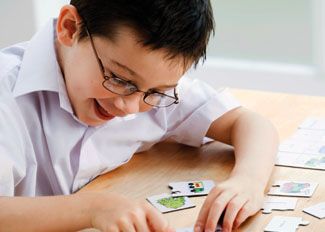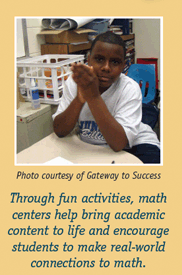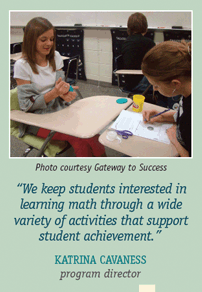 |
|
 |

Math Centers Afterschool is all about doing things differently, and mathematics enrichment is no exception. Instead of teaching another math lesson, you may want to consider the fun and flexibility of math centers. Math centers are small-group stations that let students work together on fun activities like puzzles, problems that use manipulatives (physical objects that help students visualize relationships and applications), and brainteasers. For example, students can improve their ability to make and test predictions by outlining their hands and feet on graph paper and predicting whether their hand or foot has the greatest length and width. At another center, they can practice adding, subtracting, multiplying, and dividing decimals as they try to determine how to use $65 to feed four people when ordering food from a restaurant menu. Day-school teachers can help you get started creating the centers by sharing what math concepts students are studying. You should also consider what activities students enjoy and find ways to incorporate math concepts and skills into them. Students with an interest in art might enjoy using pentominoes (sets of small squares) to form different shapes. Once you have outlined the math centers, set aside space and secure supplies. Students will most likely show greater interest if they see the centers as a fun challenge rather than another assignment. As students work at the different centers, you can circulate among the groups, offering guidance and feedback. Research suggests that math centers can encourage students to learn with less instructor guidance and increase their enthusiasm for learning by allowing them to make choices, work together, and talk about math. Through fun activities, math centers help bring academic content to life and encourage students to make real-world connections to math. You can learn more about math centers and the activities listed here in the math section of the Afterschool Training Toolkit, a free online training resource developed by the National Partnership for Quality Afterschool Learning. The math section of the toolkit was developed by Mid-continent Research for Education and Learning. |
|
 |
|

|
Gateway to Success
|
 |
 |
 |
||||||
|
|
|
|||||||
|
This email was sent by: Editor: Laura Shankland This newsletter was produced
in whole or in part with funds from the U.S. Department of Education
under contract number You are welcome to reproduce issues of AfterWords and distribute copies at no cost to recipients. Please credit SEDL as publisher. Link to PDF versions of AfterWords is available here. For additional uses, please fill out and submit a copyright request form. Copyright © 2008 by SEDL. |




